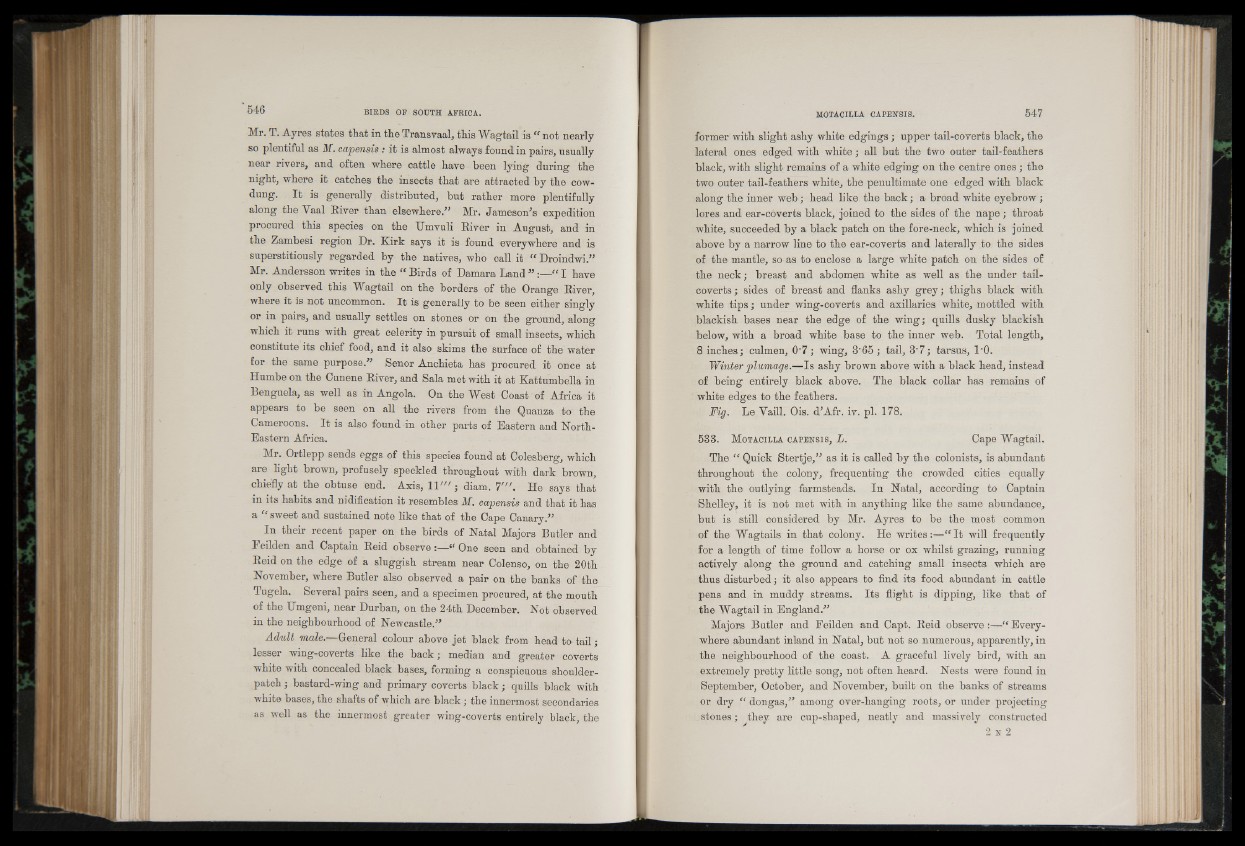
Mr. T. Ayres states that in the Transvaal, this Wagtail is f not nearly
so plentiful as M. capensis : it is almost always found in pairs, usually
near rivers, and often where cattle have been lying during the
night, where it catches the insects that are attracted by the cow-
dung. I t is generally distributed, but rather more plentifully
along the Yaal River than elsewhere.” Mr. Jameson's expedition
procured this species on the Umvuli River in August, and in
the Zambesi region Dr. Kirk says it is found everywhere and is
superstitiously regarded by the natives, who call it “ Droindwi.”
Mr. Andersson writes in the “ Birds of Damara Land ” \—“ I have
only observed this Wagtail on the borders of the Orange River,
where it is not uncommon. It is generally to be seen either singly
or in pairs, and usually settles on stones or on the ground, along
which it runs with great celerity in pursuit of small insects, which
constitute its chief food, and it also skims the surface of the water
for the same purpose.” Senor Anchieta has procured it once at
Humbe on the Cunene River, and Sala met with it at Kattumbella in
Benguela, as well as in Angola. On the West Coast of Africa it
appears to be seen on all the rivers from the Quanza to the
Cameroons. It is also found in other parts of Eastern and North-
Eastern Africa.
Mr. Ortlepp sends eggs of this species found at Colesberg, which
are light brown, profusely speckled throughout with dark brown,
chiefly at the obtuse end. Axis, 11'" ; diam. T " . He says that
in its habits and nidification it resembles M. capensis and that it has
a “ sweet and sustained note like that of the Cape Canary.”
In their recent paper on the birds of Natal Majors Butler and
I eilden and Captain Reid observe :—“ One seen and obtained by
Reid on the edge of a sluggish stream near Colenso, on the 20th
November, where Butler also observed a pair on the banks of the
Tugela. Several pairs seen, and a specimen procured, at the mouth
of the TJmgeni, near Durban, on the 24th December. Not observed
in the neighbourhood of Newcastle.”
Adult male.—General colour above jet black from head to tail;
lesser wing-coverts like the back; median and greater coverts
white with concealed black bases, forming a conspicuous shoulder-
patch ; bastard-wing and primary coverts black; quills black with
white bases, the shafts of which are black ; the innermost secondaries
as well as the innermost greater wing-coverts entirely black, the
former with slight ashy white edgings ; upper tail-coverts black, the
lateral ones edged with white; all but the two outer tail-feathers
black, with slight remains of a white edging on the centre ones; the
two outer tail-feathers white, the penultimate one edged with black
along the inner web; head like the back; a broad white eyebrow ;
lores and ear-coverts black, joined to the sides of the nape; throat
white, succeeded by a black patch on the fore-neck, which is joined
above by a narrow line to the ear-coverts and laterally to the sides
of the mantle, so as to enclose a large white patch on the sides of
the neck; breast and abdomen white as well as the under tail-
coverts ; sides of breast and flanks ashy grey; thighs black with
white tips; under wing-coverts and axillaries white, mottled with
blackish bases near the edge of the wing; quills dusky blackish
below, with a broad white base to the inner web. Total length,
8 inches; culmen, 0 '7 ; wing, 3‘65 ; tail, 3-7; tarsus, 1‘0.
Winter plumage.—Is ashy brown above with a black head, instead
of being entirely black above. The black collar has remains of
white edges to the feathers.
Fig. Le Vaill. Ois. d'Afr. iv. pi. 178.
533. M otacilla c a pen s is , L. Cape Wagtail.
The “ Quick Stertje,” as it is called by the colonists, is abundant
throughout the colony, frequenting the crowded cities equally
with the outlying farmsteads. In Natal, according to Captain
Shelley, it is not met with in anything like the same abundance,
but is still considered by Mr. Ayres to be the most common
of the Wagtails in that colony. He writes:—“ It will frequently
for a length of time follow a horse or ox whilst grazing, running
actively along the ground and catching small insects which are
thus disturbed; it also appears to find its food abundant in cattle
pens and in muddy streams. Its flight is dipping, like that of
the Wagtail in England.”
Majors Butler and Feilden and Capt. Reid observe :—“ Everywhere
abundant inland in Natal, but not so numerous, apparently, in
the neighbourhood of the coast. A graceful lively bird, with an
extremely pretty little song, not often heard. Nests were found in
September, October, and November, built on the banks of streams
or dry “ dongas,” among over-hanging roots, or under projecting
. stones; they are cup-shaped, neatly and massively constructed
2 n 2